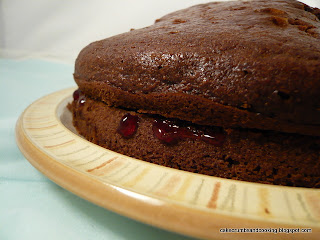I needed something super speedy to prepare, requiring no attention to bake and that didn't need copious icing or frosting afterwards to make it look attractive. These are the stipulations of someone baking late in the evening whilst simultaneously making and eating dinner, but with a surplus of eggs to use.
Chocolate vanilla marble cake it was. Quick and easy to mix and bake, and the marbling effect means that the lack of icing is not noticed in the way it would be in a plain cake. Stork margarine is your friend here - straight from fridge to mixing bowl in the way that butter just won't do. I'm fairly sure it's the secret to the superbly light texture of this cake too.
Chocolate and Vanilla Marble Cake
Ingredients
200g stork
200g caster sugar
3 very large eggs (mine weighed 214g total, so probably 4 smaller eggs)
200g plain flour
2tsp baking powder
1tsp vanilla extract
2tbsp cocoa powder
Method
- Preheat the oven to gas 4/180C. Grease and line an 8"/20cm square cake tin and put liners in a 6 hole muffin tin too.
- Place all ingredients (except cocoa powder) into the bowl of a stand mixer (or a normal bowl and use a handheld electric mixer). Mix until all the ingredients are well combined and the mixture is light in colour and texture.
- Dollop half of the mixture randomly into the tin. I also made four little cakes too - it looked as though there would be too much mixture for the tin.
- Add the cocoa powder to the mixture remaining in the bowl and mix again until all combined.
- Dollop the now-chocolate mixture into the gaps left from the first time round.
- Swirl. I used the handle of my silicon spoon - you don't want something too narrow, but neither does it want to be too chunky.
- Bake the smaller cakes for 20-25 minutes and the large cake for 40 minutes.
- Allow to cool slightly, then remove to a wire rack to cool completely.
- Slice and serve.
That's it. Simple as.
Super light, super moist and extremely easy. Not too much washing up either, which is always a bonus :-)





















































